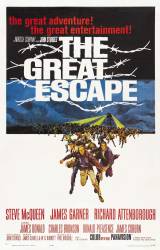Trivia: While Steve McQueen performed most of his own stunts, the only stunt he didn't perform was the 60 foot jump over the Austrian-Swiss border fence. The jump was performed by stuntman Bud Ekins, who later doubled for McQueen in "Bullitt."
Trivia: Paul Brickhill, who wrote the novel the film is based on, was a member of the X organization which planned the escape.
Trivia: The motorcycle used by Steve McQueen is the same motorcycle Henry Winkler used on "Happy Days."
Trivia: Steve McQueen, James Coburn, and Charles Bronson previously starred together in another John Sturges movie, "The Magnificent Seven."
Trivia: Jill Ireland was married to David McCallum at the time this film was made. She later married Charles Bronson.
Trivia: In the scene following Hilts' theft of a German motorcyle, he rolls into a German town, where he is stopped by a police officer; the officer says something to Hilts, who then kicks him away and rides off. He was asked for identification papers he didn't have.
Trivia: Donald Pleasance is the only actor to appear in both this film and the 1988 TV movie "The Great Escape II: The Untold Story"; here he plays one of the would be great escapees, and in the sequel, he played a member of the S.S.
Trivia: Donald Pleasence was an RAF pilot and a genuine POW. His plane was shot down, and he was interned in a German camp. In an interview about The Great Escape he said that the film's producers weren't interested in hearing his suggestions about making the camp scenes more realistic, so "I simply learned to shut my mouth."
Trivia: David McCallum, whose character is killed at the railway station while trying to escape, says that his daughter Sophie has never been able to watch this movie, "Because she cannot stand the thought of seeing her father shot."
Trivia: The actual camp site, which can still be visited, is in Zagan, Poland, which was, during the war, part of the Greater Reich.
Trivia: The actor Steve McQueen was no stranger to "cooler life"; he had a criminal record as a youth and while in the US Marines spent 41 days in the brig.






Suggested correction: These prisoners were being transferred from other camps to this camp. As Big X said, "They are putting all their rotten eggs in one basket." It's likely they are carrying possessions they've acquired during their time in captivity.
What "possessions"? Do you think they had Oxfam shops in POW camps during World War 2? They would be dressed in their combat fatigues and nothing else.
They would have possessions as they would receive parcels from home and Red Cross parcels.
Prisoners of war would receive Red Cross parcels, and may have also scrounged, made or been issued a few other bits and pieces. In particular, they'd probably have a change or two of underwear, some toiletries and a few books or games at the very least.
POWs acquired possessions by hand-making, scrounging, care packages, 'selling' watches and rings to guards or local civilians.
Agreed, there was always a bit of trading going on for little trinkets. As has happened in many wars.
Ssiscool ★
They were universally known for their trading and scrounging abilities. Remember these were the "worst of the worst" in offending.
stiiggy
Just to clarify. They weren't exactly the "worst of the worst" for bad or incorrigible behavior. They were the best at attempting to escape POW camps or otherwise subverting their German captors. The fed-up Germans decided to contain them all in one prison to stop the constant breakouts. They only succeeded in creating a POW "think tank" by pooling together the most talented escape artists who combined their skills and knowledge.
raywest ★
In international conflicts, in addition to prisoners regularly receiving Red Cross care packages, the Geneva Convention requires captors to treat all POWs humanely, and provide food, clothing, housing, medical treatment, and hygiene. As mentioned, these prisoners brought their belongings with them from other camps. International Red Cross inspectors monitor POW camps for compliance. Failure to comply with the rules constitutes war crimes, which are adjudicated after a conflict. Germany was generally compliant. POW camps were to detain captured soldiers and prevent them rejoining the war. They did not punish detainees as "criminals" but disciplined them when they were non-compliant or for other misbehavior. Once the war was over, POWs were repatriated.
raywest ★
The Great Escape was from a POW camp specifically set up to hold trouble makers from other camps. Also, sometimes people expect to be captured and prepare to for it! Today, during funeral of John Lewis, speakers repeatedly mentioned that he was carrying a backpack with 2 books, an apple, an orange and a tooth brush. Which haven't been seen since his head was beat in. A least one German Fortress commander, sworn to defend his fort until he and all those under his command were dead, surrendered with multiple suit cases to make his incarceration more comfortable. Like the character Yossarian in Catch-22. [Spoiler alert: he makes elaborate preparations to the paddle in a life raft from Italy to Sweden.].